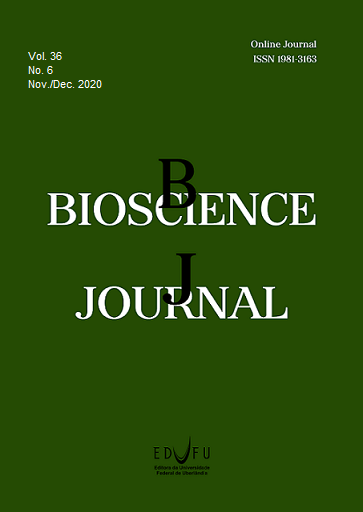Zinc - rooting cofactor in rubber tree mini-cuttings
DOI:
https://doi.org/10.14393/BJ-v36n6a2020-48170Keywords:
Hevea brasiliensis, Mini-cutting technique, Vegetative propagation, Cloning, Root inductionAbstract
The rubber tree (Hevea brasiliensis Müell. Arg.) is a species of significant economic interest in the natural rubber industry in Brazil and the world. This species presents recalcitrance to rooting, and its cuttings are difficult to propagate. This study aimed to evaluate the effect of the pre-conditioning of rubber tree mini-cuttings with zinc on the improvement of the adventitious rooting of rootstocks. Mini-cuttings were standardized with 45 mm length and submitted to preconditioning by immersion of the mini-cutting base in solutions containing 0.00; 0.04; 0.08; 0.16; 0.32 and 0.64 mg L-1 of Zn, for 24 hours. The experimental design was randomized blocks with six treatments and four replicates of 10 mini-cuttings. The rubber tree mini-cuttings were placed in a fitotron-type growth chamber, at 25 °C, with 12-hour photoperiod, 5,000 K intensity, and 95% of relative air humidity, for 60 days. The survival rate, number of buds, percentage of mini-cuttings that had leaf abscission, the percentage of mini-cuttings with callogenesis in the root meristem, the percentage of rooted mini-cuttings, the number of primary roots and root length were evaluated. The highest values of survival rate, the number of buds, the number of primary roots, the percentage of mini-cuttings with callogenesis in the root meristem, the percentage of rooted mini-cuttings and root length were observed with 0.16 to 0.26 Mg L-1 of Zn. The use of zinc in the mini-cuttings of rubber tree reduces linearly the percentage of mini-cuttings that had leaf abscission and the formation of callogenesis in the root meristem.
The rubber tree (Hevea brasiliensis Müell. Arg.) is a species of a large economic interest in the natural rubber industry in Brazil and the world. This species presents recalcitrance to rooting, and its cuttings are difficult to propagate. This study aimed to evaluate the effect of the pre-conditioning of rubber tree mini-cuttings with zinc on the improvement of the adventitious rooting of rootstocks. Mini-cuttings were standardized with 45 mm length and submitted to preconditioning by immersion of the mini-cutting base in solutions containing 0; 0.04; 0.08; 0.16; 0.32 and 0.64 mg L-1 of Zn, for 24 hours. The experimental design was randomized blocks with six treatments and four replicates of 10 mini-cuttings. The rubber tree mini-cuttings were placed in a fitotron-type growth chamber at 25 °C, with 24-hour photoperiod, 5,000 K intensity and 95% relative humidity for 60 days. The survival rate, number of buds, percentage of mini-cuttings that had leaf abscission, the percentage of mini-cuttings with callus, the percentage of rooted mini-cuttings, the number of primary roots and root length were evaluated. The highest values of survival rate, the number of buds, the number of primary roots, the percentage of mini-cuttings with callus, the percentage of rooted mini-cuttings and root length were verified with 0.16 to 0.26 Mg L-1 of Zn. The use of zinc in the mini-cuttings of rubber tree reduces linearly the percentage of mini-cuttings that had leaf abscission and the formation of root calluses.
Downloads
Downloads
Published
How to Cite
Issue
Section
License
Copyright (c) 2020 Joelmir Vital da Silva, Wilson Itamar Maruyama, Carlos Eduardo da Silva Oliveira, Fabio Steiner, Alan Mário Zuffo, Tiago Zoz

This work is licensed under a Creative Commons Attribution 4.0 International License.





